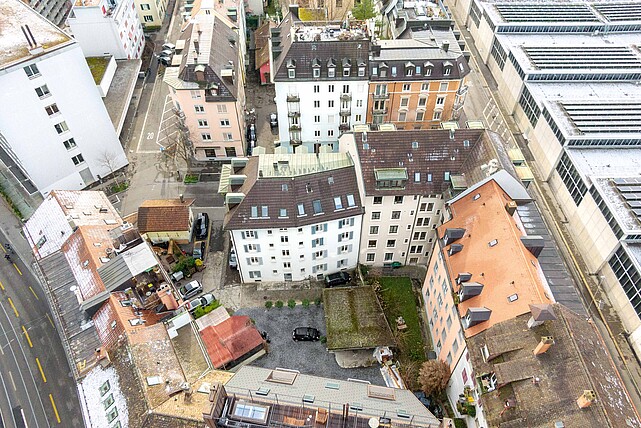The call for sustainability in the real estate sector has been considerable for some time. This is clear from the fact that more and more companies are publicising their CO2 reduction paths for the coming decades. The effects of CO2 emissions can already be seen in the form of higher temperatures in urban areas and extreme weather events.
Biodiversity concepts in combating heat island effects
In densely developed urban areas, higher temperatures can already be felt on sizzling summer nights. In heat islands (urban heat island effect), heat is absorbed by buildings during the day, stored and released into the environment at night. This effect causes night temperatures to be measurably higher than those in built-up areas. The city of Zurich estimates that the number of hot days will rise dramatically in the coming years, with tropical nights more than doubling.
Central locations are still in high demand from both renters and real estate investors, a trend clearly shown in yield development in recent years. Heat generation in buildings and diverse environmental conditions also have a relevant impact on tenant fluctuation. Every change of occupancy comes with lost income or increased expenses.
A biodiversity concept starts here and shows ways for properties to be enhanced, better positioned, and contribute to fighting climate change long-term. The benefits of biodiversity concepts, however, are still often neglected, regarded as not relevant to property value. But doesn’t the difficulty lie in the fact that their impact on the property’s value cannot be directly measured?
An example from our portfolio: “Grün Stadt Zürich”
To identify possible measures, SFP Investment Foundation inspected “Grün Stadt Zürich”, an investment property in the Kalkbreite complex with residential and commercial use, close to Wiedikon train station in Zurich. “Grün Stadt Zürich” aims to reduce overheating in the entire quarter and promote biodiversity.
Due to the property’s central location, the amount of green space is currently limited to balcony planting by the current tenants. Its inner courtyard consists of a paved bitumen surface. One possible, cost-intensive option would involve a vertical green wall alongside demolishing the sealed ground surface. Another option, with a lower level of intervention, would involve the installation of plant containers, because even the smallest areas support the proliferation of flora and fauna.
Investigation on simple extensive green roofs
It quickly became clear during the inspection that not all measures could be implemented. For example, scaffolding is necessary for the addition of another floor; anchors for green façades could be prepared at the same time. During the planned levelling-out work on the ground in the inner courtyard, the sealed surface could be removed with minimal costs. Such measures will not immediately bring higher yields, but will result in an improved climate, due to the loosened soil which will no longer store heat to the extent that it did before.
A newly created green space, for example in the form of a flat green roof, provides a new habitat for a variety of fauna – a “steppingstone” biotope. The more of these biotopes we create, the sooner we’ll see plants and animals returning to the area. Turning flat roofs into green roofs results in improved temperature regulation in the building itself, greatly benefiting older properties that were not built to Minergie standards.
Green roofs for the future
In contrast to extensive greening, green roofs require higher load-bearing capacity as well as certain maintenance measures and are therefore not suitable for every property. Additional installation of a photovoltaic system is also an option in connection with a green roof. This should be factored in at the planning stage when choosing the plants as well as selecting the support structure. Easy access to the plants will help reduce maintenance over the long term.
Finally, biodiverse spaces help to improve building quality and increase the satisfaction of tenants in all types of buildings. Investments in this area should be conceived and assessed long-term in connection with work already planned on the properties so that essential synergies can be utilised, costs optimised, and building values increased over time.


